Computational Water, Energy, and Environmental Engineering
Vol. 1 No. 1 (2012) , Article ID: 18612 , 7 pages DOI:10.4236/cweee.2012.11001
GA-Fuzzy Decision Support System for Mercury Removal in Natural Waters
1Department of Civil Engineering, Jerash University, Jerash, Jordan
2Building, Civil and Environmental, Concordia University, Montreal, Canada
3École Polytechnique de Montreal, Mechanical Engineering, Montreal, Canada
Email: argg22@yahoo.com
Received February 28, 2012; revised March 25, 2012; accepted April 5, 2012
Keywords: GA; Fuzzy Logic; Decision Support System; Heavy Metals; Natural Waters
ABSTRACT
The idea of this research is to apply sustainability and augment efficiency of the aquatic systems by intelligent tools. This paper exploits fuzzy logic approach as a flexible methodology for providing supplementary information about mercury removal in natural waters. Fuzzy logic generates information on Hg behaviour in water according to its uptake by bio-species and adsorption by sediments. Fuzzy Decision Support System (FDSS) comprises knowledge base (i.e. premises and conclusions), fuzzy sets, and fuzzy rules. Knowledge base and rules are being built manually and by algorithm. GA-FDSS incorporates genetic algorithm GA to build optimal approximation for knowledge base, fuzzy sets, and rules. The role of integrating GA with FDSS is to train knowledge base and rules automatically from available data, hence FDSS models and predicts conclusion acquired. The findings of this research show more than 95% correlation between observed data and soft computed data. The optimal biological uptake occurs at pH of 5.5. The optimal sediment adsorption occurs at pH of 8. The final mercury concentration calculated in natural waters is about 7 ´ 10–8 mole/L. The results show that the removal efficiency of mercury by natural waters approaches 97%. Consequently the obtained fuzzy logic informative hierarchy is proficient to manage metals removal by aquatic systems.
1. Introduction
In environmental engineering, natural ecosystems have been used as an efficient low-cost treatment processes for polluted waters [10]. Natural waters normally receive pollutants from human activities. The release of heavy metals into natural environments affects human and ecological ecosystems [22]. The presence of heavy metals in the environment is of major concern because of their toxicity, bio-accumulating tendency, threat to human life and the environment [25,26]. Heavy metals can be partitioned to natural water components in different ways. The allocation of heavy metals to water components depends on variable environmental conditions [14,17]. The removal of metals from the water column within an aquatic system (e.g. streams, ponds, reservoirs, lakes) is achieved generally by biological uptake by bio-species and by adsorption onto sediments.
A large quantity of materials has been investigated as biosorbents for the removal of metals extensively. The tested biosorbents can be basically classified into the following categories: bacteria (e.g. Bacillus subtillis), fungi (e.g., Rhizopus arrhizus), yeast (e.g., Saccharomyces cerevisiae), algae, industrial wastes (e.g., S. cerevisiae waste biomass from fermentation and food industry), water plants (e.g., Water Hyacinths and Reeds) [24]. The most important removal process in wetlands is biological by uptake in roots, stems and Leaves in plants [27]. The main route of metal uptake in aquatic plants was through the roots in surface floating plants, where roots and leaves take part in removing heavy metals and nutrients. Submerged rooted plants have metal uptake potential from water as well as sediments [28].
2. Methodology
In this research, genetic algorithm and fuzzy logic are being used to model, assess, and predict mercury removal in natural waters. Investigational data and information for mercury bioavailability in water and adsorption on sediments were adopted from previous research work conducted in Concordia University-Canada [1,5,6,8,11, 12]. The concept of utilizing genetic algorithm and fuzzy logic expert system to manage natural processes is being applied here by using GA-FDSS software that was developed by the third author, professor Balazinski at École Polytechnique de Montréal-Canada [2,3].
3. Fuzzy Decision Support System and Genetic Algorithm
Fuzzy logic is a superset of conventional logic that has been extended to handle the concept of partial truth, truth-values between “completely true” and “completely false”. It was introduced by Lotfi Zadeh of UC/Berkeley in the 1960’s as a mean to model the uncertainty of natural language. Fuzzy Logic is a departure from classical two-valued sets and logic, which uses “soft” linguistic (e.g. large, hot, tall) system variables and a continuous range of truth-values in the interval (0, 1), rather than strict binary (True or False) decisions and assignments [23].
Fuzzy logic is derived from fuzzy set theory dealing with reasoning that is approximate rather than precisely deduced from classical predicate logic. It can be thought of as the application side of fuzzy set theory dealing with well thought out real world expert values for a complex problem.
In classical set theory, a subset U of a set S can be defined as a mapping from the elements of S to the elements of the set {0, 1}:

This mapping may be represented as a set of ordered pairs, with exactly one ordered pair present for each element of S. The first element of the ordered pair is an element of the set S, and the second element is an element of the set {0, 1}. The value zero is used to represent non-membership, and the value one is used to represent membership.
The truth or falsity of the statement:
x is in U is determined by finding the ordered pair whose first element is x. The statement is true if the second element of the ordered pair is 1, and the statement is false if it is 0. For example, the measure of temperature has to be transformed into a “high” or “low” value with a respective degree of membership, before being processed by the inference engine.
For any set S, its characteristic function fS(x) describes whether or not an element x is an element of the set S. Where fS(x) = 1 if true, and fS(x) = 0 if false.
In Boolean logic: 
In Fuzzy logic, µS(x) describes the membership function of S, or the degree to which x is a member of the set S, this is known as the degree of truth:

For the universe X and given the membership degree function μ{0, 1} the fuzzy set A is defined as:

The membership function μA(x) quantifies the grade of membership of the elements x to the fundamental set X. The value 0 means that the member is not included in the given set, 1 describes a fully included member. The values between 0 and 1 characterize fuzzy members Fuzzy decision support systems (FDSS) comprise rulebased approach to decision making using fuzzy logic techniques, based on the compositional rule of inference (CRI). This approach is used to handle uncertain knowledge that can be collected and delivered by a human expert like decision-maker or designer. The CRI may be written in the following form:
 (1)
(1)
where:  represents the output (conclusions);
represents the output (conclusions);  represents the inputs (observations); the symbol
represents the inputs (observations); the symbol  represents the CRI operator; R represents the global relation that aggregates all rules (knowledge base) [3].
represents the CRI operator; R represents the global relation that aggregates all rules (knowledge base) [3].
Fuzzy rule-based systems are being applied to solve many types of real-world problems, especially where a system is difficult to model. Human operator or expert controls these systems. A typical fuzzy system consists of a rule base, membership functions, and inference procedures. Three defuzzification methods are usually available, i.e. center of area (COA), average of maximums (AOM), and the modified center of area (MCOA).
Genetic algorithms (GA) deal with stochastic search method introduced in the 1970s by researchers such as Holland (1975) and Ingo Rechenberg (1973) [19,20]. GA is an optimization technique that simulates and imitates the analogy of biological genetics and emulates the phenomenon of selection of the fittest approach [16]. Based on generalization of natural evolutionary processes, genetic algorithms operate on a population of solutions rather than a single solution. Each individual of a population is a potential knowledge base that is encoded before applying four operations: crossover, mutation, evaluation/ natural selection, and decoding [15,18,21].
In GA-FDSS, the GA produces an optimal approximation of a set of sampled data from a certain amount of input information [4]. The GA uses two main contradictory optimization criteria (i.e. the approximation error and the complexity level of the knowledge base). The approximation error is computed as the root mean square error between the sampled outputs and the answers of FDSS at the corresponding sampled input data. The complexity level is computed as the number of fuzzy rules contained in the knowledge base. The GA deals with many other criteria that also control the optimization process, e.g. the probability of crossover, the probability of fuzzy-sets displacement, the probability of fuzzy-rules reduction and the probability of mutation [15].
3.1. Fuzzy Decision Support System for Mercury Speciation
The Fuzzy Decision Support System was constructed manually into two premises (mercury concentration and pH) and one conclusion to predict mercury bioavailability for species bio-uptake (Figure 1).
FDSS solutions were applied for any particular situation where natural conditions satisfy the following combination of parameters:
- Initial concentration of total mercury is in the range between 2.5 ´ 10–8 and 1 ´ 10–3 mole/l;
- The pH value is situated between 5.36 and 8 [7,9].
The settings of FDSS implemented to maximum-minimum inference, COA defuzzification, MIN aggregation, MIN propagation, and MAX fusion. Nine rules were assigned to infer fuzzy premises into conclusion.
FDSS was able to predict the speciation of bioavailable mercury for variable combination of initial mercury concentration and pH. Subsequently, comparison is conducted between results obtained from the model of FDSS and experimental results (Figure 2).

Figure 1. FDSS settings, premises, conclusion, and rules for mercury bioavailability within natural waters.
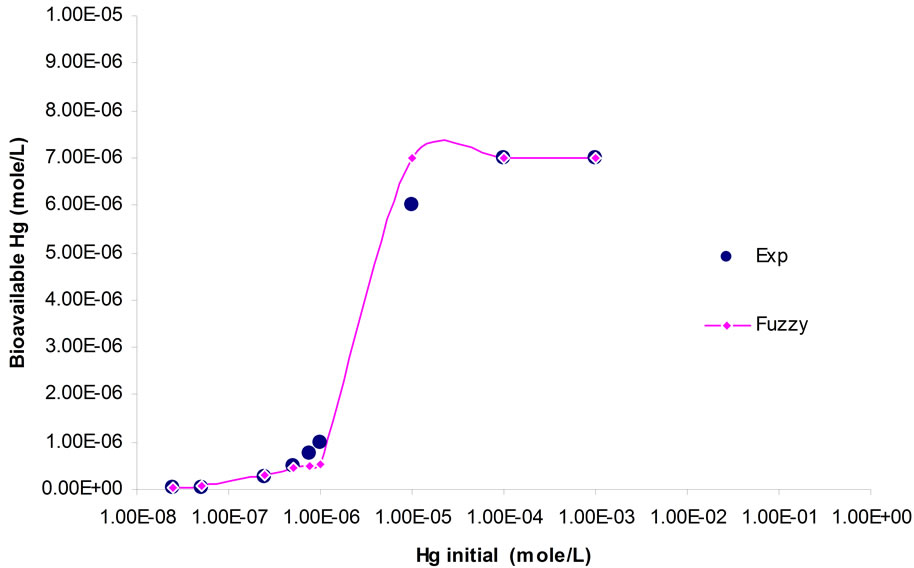
Figure 2. FDSS modeling for bioavailable mercury vs. initial mercury concentration in water when pH equals 5.36.
3.2. GA FDSS for Mercury Adsorption
When genetic algorithm in FDSS is in a steady state, a newly-born child replaces the worst genotype of the population (data) in the process of creating solution using genetic operators. This process is repeated until optimization criterion is met, which normally takes place when many of iterations have been accomplished. Hence genetically generated knowledge bases are ready for fuzzy inference system.
The Genetic Algorithm is conducted through the following processes:
1) Coding scheme for each possible solution by using a finite string of bits in the chromosome.
2) Fitness value is assigned to each solution to check the quality of solution.
3) Initial set of solutions to the problem, called initial population, is randomly generated or chosen according to prior knowledge.
4) A set of reproduction is performed through mutation and natural selection operators that allow the development of the population.
To assess mercury removal by adsorption on sediments in natural aquatic systems, where the specific surface area is 130 m2/g and the adsorbent concentration is 10 g/l, GA-FDSS was applied for following variable conditions:
- The initial concentration of total mercury is in the range between 1 ´ 10–7 to 1 ´ 10–3 moles;
- The pH value is located between 5.36 to 8.
Investigational data for mercury adsorption for differrent pH values are shown in Table 1. After GA approximates the knowledge base, GA-FDSS model is able to simulate and predict mercury sorption on sediments (Figure 3). For certain initial mercury concentrations the adsorbed mercury is decreasing from its upper value when pH equals 8 to its lower value when pH equals 5.36 (Table 2). GA-FDSS was able to model mercury adsorption with high correlation to experimental data as shown in Figure 4.
4. Removal Efficiency
The knowledge obtained in previous sections by fuzzy decision support systems is being used to assess removal efficiency. Heavy metal removal is allocated to uptake by bio-species and adsorption by sediments (Figure 5). The optimal biological uptake occurs at pH of 5.5. The optimal sediment adsorption occurs at pH of 8. The initial mercury concentration reported in natural waters is about 7 ´ 10–7 mole/L (Table 3). The results show that the removal efficiency of mercury by natural waters approaches 97% (Figure 6).
In the view of sorption mechanism that is implied in this research, Thomas expression for adsorption in columns [13] spots the light about sorption capacity to be
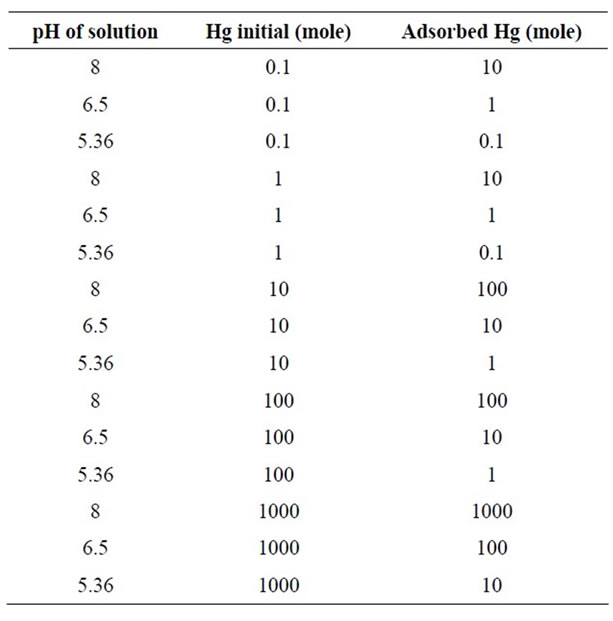
Table 1. Investigations of Adsorbed Hg concentration vs. (Hg Initial-pH of Solution), where the sediment concentration equals 10 g/L, and soil specific surface area equals 130 m2/g [6].
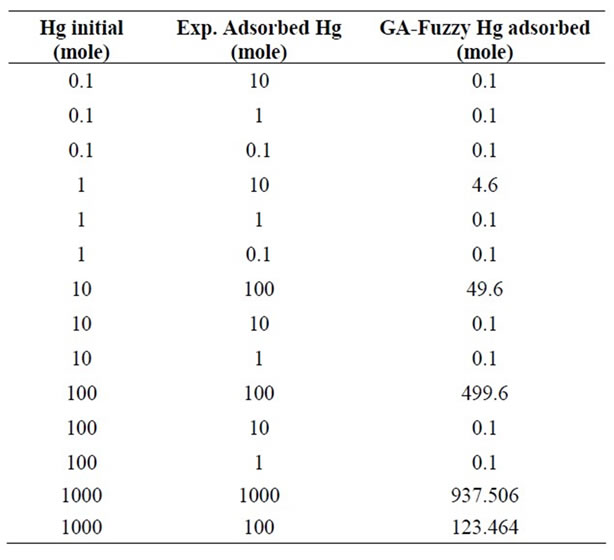
Table 2. Experimental and FDSS-GA results for different initial mercury concentration and for different pH values, where the sediment concentration equals 10 g/L, and soil specific surface area equals 130 m2/g.
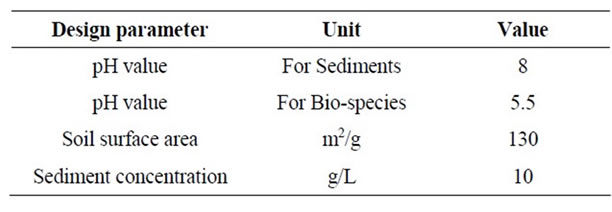
Table 3: Parameters value for aquatic systems for optimal mercury removal.

Figure 3. GA-FDSS settings, premises, conclusion, and rules for mercury adsorption on sediments within natural waters.

Figure 4. Comparison between Experimental and FDSS-GA results for different initial mercury concentration, when pH is varying between 5.36 - 8, for natural soil, where specific surface area equals to 130 m2/g and the adsorbent concentration equals to 10 g/L.
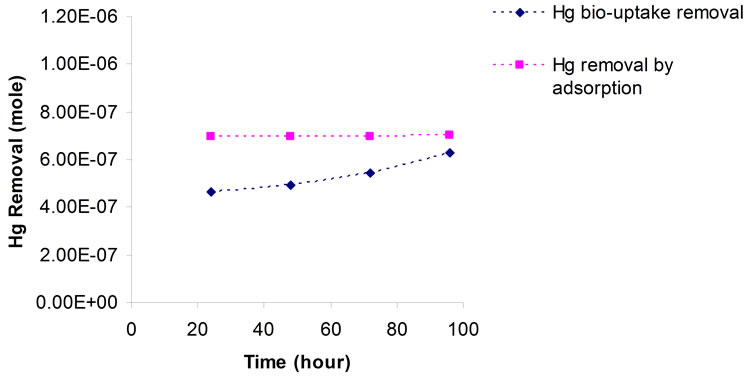
Figure 5. Mercury removal by bio-uptake and sediment adsorption in natural waters during 4 days (findings of FDSS for pH of 6.5 and initial Hg of 7E-7 mole/l).
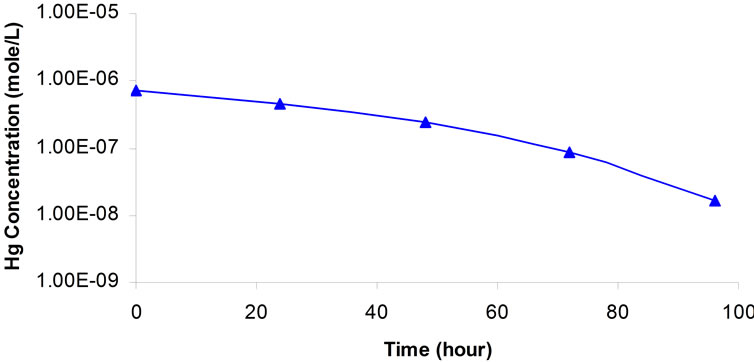
Figure 6. Net Hg concentration during four days of time in aquatic natural system (findings of FDSS).
taken in consideration. The sorbing materials are renewed in nature, so if this system is to be engineered in a confined system, then the sorbing materials should not approach their capacity, or the system left naturally regenerated.
5. Conclusion
This research implies fuzzy decision support system to evaluate and manage mercury sorption in natural waters. FDSS model is consisted of premises, conclusion and rules to judge the conclusion from given input. FDSS models and predicts the amount of mercury uptaken by biological species and that adsorbed by sediments. The results of this research show more than 95% fitness between observed data and modeled data by fuzzy. The optimal biological uptake occurs at pH of 5.5. The optimal sediment adsorption occurs at pH of 8. The removal efficiency of mercury in natural waters approaches 97%. The findings and scenarios presented in this research can be applied to intelligent and sustainable water systems for heavy metal removal.
6. Acknowledgment
The financial support from the Natural Sciences and Engineering Research Council of Canada under grant RGPIN-18948 is gratefully acknowledged.
REFERENCES
- J. D. Allison, D. S. Brown and K. J. Novo-Gradac, “MINTEQA2/PRODEFA2, a Geochemical Assessments Model for Environmental Systems: Version 3.0 User’s Manual,” Environmental Research Laboratory, Athens, 1991.
- M. Kantrowitz, E. Horstkotte and C. Joslyn, “What is a fuzzy logic?” 1993. http://www-2.cs.cmu.edu/Groups/AI/html/faqs/ai/fuzzy/part1/faq-doc-4.html
- M. Balazinski and K. Jemielniak, “Tool Conditions Monitoring Using Fuzzy Decision Support Systems,” 5th International Conference on Monitoring and Automatic Supervision in Manufacturing, Warsaw, 20-21 August 1998, pp. 115- 122.
- L. Baron, “Genetic Algorithm for Line Extraction,” École Polytechnique de Montréal, Montreal, 1998.
- A. El-Agroudy and M. Elektorowicz, “Kinetics of Inorganic Mercury Removal from Surface Water by Water Hyacinths and Reeds,” 34 CCSWPR, Burlington, 1999.
- A. El-Agroudy, “Investigation of Constructed Wetland Capability to Remove Mercury from Contaminated Waters,” Ph.D. Thesis, Concordia University, Montreal, 1999.
- E. Maria, B. Marek and Q. Ahmad, “Application of the AI to Estimate the Constructed Wetland Response to Heavy Metal Removal,” ASCE/CSCE Conference on Environmental Engineering, Niagara Falls, 25-28 July 2002, p. 151.
- R. J. Hunter, “Introduction to Modern Colloid Science,” Oxford University Press Inc., New York, 1993.
- A. Qasaimeh, “Application of the Artificial Intelligence to the Design of Constructed Wetlands for Heavy Metal Removal,” Master thesis, Concordia University, Montreal, 2003.
- P. Stephen and J. Curtis, “Physical and Chemical Characteristics of Freshwater Wetland Soils,” In: D. A. Hammer, Ed., Constructed Wetlands for Wastewater Treatment: Municipal, Industrial, and Agricultural, Lewis Publishers, Chelsea, 1989, pp. 41-72.
- K. H. Tan, “Principles of Soil Chemistry,” Marcel Dekker Inc., New York, 1982.
- R. N. Yong, A. M. O. Mohamed and B. P. Warketin, “Principles of Contaminant Transport in Soils,” Elsevier, Amsterdam, 1992.
- T. D. Reynolds, “Unit Operations and Processes in Environmental Engineering,” Brooks/Cole Engineering Division, Monterey, 1982.
- M. Elektorowicz and A. Qasaimeh, “Fuzzy Modeling Estimation of Mercury Removal by Wetland Components,” Processing NAFIPS ’04. IEEE Annual Meeting of the Fuzzy Information, Chicago, 27-30 June 2004, pp. 37-40.
- M. Balazinski, S. Achiche and L. Baron, “Influences of Optimization and Selection Criteria on Genetically-Generated Fuzzy Knowledge Bases,” International Conference on Advanced Manufacturing Technology, Johor Bahru, 29-30 November 2000, pp. 159-164,.
- L. Baron, S. Achiche and M. Balazinski, “Fuzzy Decision Support System Knowledge Base Generation Using a Genetic Algorithm,” International Journal of Approximate Reasoning, Vol. 28, No. 2-3, 2001, pp. 125-148. doi:10.1016/S0888-613X(01)00047-0
- E. Maria, B. Marek and Q. Ahmad, “Assessment of the Capacity of Metal Sorption to Sediments of Natural Systems Using Fuzzy Knowledge,” CSCE Canadian Society for Civil Engineering 31st Annual Conference, Moncton, 4-7 June 2003.
- G. Mitsuo and C. Runwei, “Genetic Algorithms and Engineering Design,” Wiley, New York, 1997.
- J. Holland, “Adaptation in Natural and Artificial Systems,” The University of Michigan Press, Ann Arbor, 1975.
- I. Rechenberg, “Evolutionsstrategie: Optimierung Technischer Systeme Nach Prinzipien der Biologischen Evolution,” Frommann-Holzboog Verlag, Stuttgart, 1973.
- S. P. Ronald, “Preserving Diversity in Routing Genetic Algorithms: Comparisons with Hash Tagging,” University of South Australia, Adelaide, 1994.
- D. Inthorn, H. Nagase, Y. Isaji, K. Hirata and K. Miyamoto, “Removal of Cadmium from Aqueous Solution by the Filamentous Cyanobacterium,” Journal of Fermentation and Bioengineering, Vol. 82, No. 6, 1996, pp. 580- 584. doi:10.1016/S0922-338X(97)81256-1
- A. Bonde, “Fuzzy Logic Basics,” 2000. http://www.austinlinks.com/Fuzzy/basics.html
- K. Vijayaraghavan and Y.-S. Yun, “Bacterial Biosorbents and Biosorption,” Biotechnology Advances, Vol. 26, No. 2, 2008, pp. 266-291. doi:10.1016/j.biotechadv.2008.02.002
- M. H. Jnr, “Effects of Temperature on the Sorption of Pb2+ and Cd2+ from Aqueous Solution by Caladium Bicolour (Wild Cocoyam) Biomass,” Electronic Journal of Biotechnology, Vol. 8, No. 2, 2005, pp. 162-169.
- J. C. Igwe and A. A. Abia, “Maize Cob and Husk as Adsorbents for Removal of Cd, Pb and Zn Ions from Wastewater,” Physical Sciences, Vol. 2, 2003, pp. 83-94.
- A. S. Sheoran and V. Sheoran, “Heavy Metal Removal Mechanism of Acid Mine Drainage in Wetlands: A Critical Review,” Minerals Engineering, Vol. 19, No. 2, 2006, pp. 105-116. doi:10.1016/j.mineng.2005.08.006
- K. Haarstad, H. J. Bavor and T. Maehlum, “Organic and Metallic Pollutants in Water Treatment and Natural Wetlands: A Review,” Water Science and Technology, Vol. 65, No. 1, 2012, pp. 76-99.

